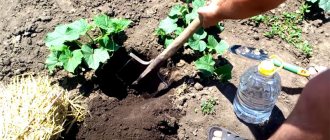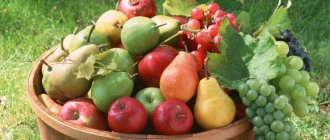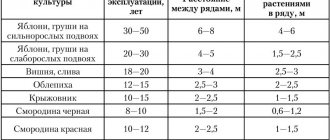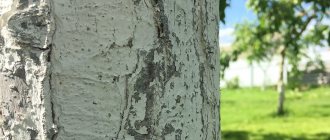When installing an irrigation system, there is often a need to irrigate not only the lawn, beds and greenhouses, but also the trees and shrubs located on the territory. This will require a certain method of watering, which promotes the growth of the root system deep into the soil, which makes the trees more durable and healthy.
What is drip irrigation? This is one of the irrigation methods based on the uniform supply of a limited amount of water directly to the root system of plants. This method saves time and uses water sparingly. But this irrigation is only suitable for small plants (tomatoes, cucumbers, peppers) and is most often used for irrigation in greenhouses.
But what to do if you have a whole garden or forest on your property? How to organize automatic watering of apple trees, cherries, plums, cherries, currants, gooseberries and other garden plants or thuja, pine, Christmas trees? For this purpose, there is a special watering system for trees and shrubs.
Trees and shrubs are often not arranged in a straight line, or even completely randomly. They can be located at different distances and at a large angle relative to each other. In this case, it is recommended to use HDPE pipes rather than drip tape, since bends will lead to creases and interruption of water flow. And in general, the volumes of water supplied through the drip tape will be completely insufficient for the trees. The HDPE tube is distinguished by its strength and is convenient in that it fits perfectly in an arc or in a circle without breaking. In this case, holes are made in the required place of the tube using a special hole punch into which the emitters are inserted. By turning the emitter, you can adjust the amount of water poured out.
There are a variety of ways to lay a pipe around trees. Or you can simply take a long coil of pipe and stretch it between the trees while making a ring around each of them and securing the ring with special pegs. In this case, you can do without fittings (tees and angles). Or you run the hose in a straight line, and then make special circular bends to each tree as shown in the figure. Aesthetically, this option will look more attractive, but will require the use of fittings.

To water trees and shrubs, we recommend using the Gardener drip irrigation system from. This kit already includes all the components necessary for installing the system, and also provides detailed assembly instructions. The “Gardener” set is mounted under any plants and allows simultaneous irrigation of trees or shrubs located at a distance of up to 4 meters from each other.
The system involves the use of drip rings with a diameter of 1.5 meters, located around the tree and providing a uniform supply of water. Thus, the roots receive the required amount of moisture evenly and in a timely manner and provide the owner with a good harvest. The complete pipe comes in a coil, so you can independently determine the diameter of the ring around the tree you need.
Advantages
- Water saving;
- A closed circle around the tree trunk ensures uniform watering;
- Possibility of using a timer that turns on automatic watering at the appointed time;
- Easy to use;
- Possibility of connection to the central water supply system.
- Regulating the amount of water poured out and the irrigation diameter by turning the emitter.
For which trees is this irrigation system suitable:
This tree drip irrigation kit is ideal for ornamental plants and fruit plants.
Fruit trees: plum, cherry, cherry, apple, pear, sea buckthorn, currant, gooseberry, cherry plum, apricot and others.
ORDER ONLINE:
1,300 rub.
RUB 1,499
RUB 1,599
RUR 2,090
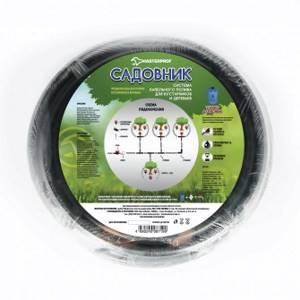
Ornamental plants: thuja, pine, spruce, juniper, maple and others.
Rules for watering trees
Most people who begin their acquaintance with growing trees are wondering: how to properly water trees for their growth and longevity?
The tree needs irrigation throughout its development. However, it is worth considering the fact that each tree species at a certain age has its own watering rate. Improper water supply and quantity can negatively affect the development of the root system and ultimately destroy the tree.

For good development, it is enough to follow the following rules:
- Recommended soil moisture during the growing season is 60% of full moisture capacity. With a lower percentage, the tree will receive fewer mineral nutrients.
- The frequency of watering depends on the stage of plant development. If the plant is young and located in a hot climate, then it is necessary to water about five times during the growing season. Older trees are less demanding and 2 times are enough for them. However, during the spring period before flowering, as well as in the fall before wintering, the roots will need more moisture.
- The amount of water for moistening depends on the depth of the roots and the maturity of the crop: seedlings will require approximately 40 liters of water, trees about five years old - 60 liters, 10-year-old plantings will require about 130-150 liters of water, old trees are less demanding and have enough 40 liters for every square meter of the circle around the trunk. You also need to take into account the component of the soil located on the garden plot. If you have to deal with sandy soil, it is recommended to reduce the amount of water poured at a time, but at the same time increase the number of waterings. For clay soil, on the contrary, immediately pour out a large amount of water at a time, but reduce the number of sprinklings.
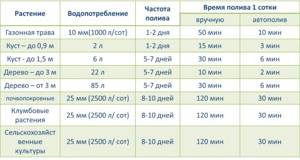
Features of drip irrigation "Beetle"
Online store for irrigation products “ZHUK”
The “Zhuk” drip irrigation system is a real help for summer residents and gardeners!
Taking care of you, for the benefit of the garden!
The modern “Zhuk” drip irrigation system creates an ideal environment for plant growth. It provides a sufficient level of soil moisture and does not require participation in the process itself. Compact and “smart” automation will irrigate up to 60 plants on the site, increasing the volume of grown crops by 30%.
Incredible!
This irrigation system, developed by Israeli gardeners, increased yields in the hot, arid country by 2.5 times and brought it to the forefront of marketing fruit and vegetable products.
Drip irrigation "Beetle" from the online store
For everyone who values reliability and prefers practical things in everyday life – “Zhuk” drip irrigation. We offer irrigation structures for gardens, vegetable gardens, flower beds, greenhouses, and lawns at manufacturer-recommended prices. We offer the following terms of interaction with buyers:
- we introduce new products in the series and are the first to report know-how;
- We provide products in any quantities and volumes;
- We accept additional orders, exchange goods (if necessary);
- We keep prices stable.
In our online store in Moscow you can buy drip irrigation “Zhuk” at 12-15% lower than in online stores. We do not inflate prices, but set adequately low tariffs for all engineering structures. Here you will find real branded products of the Russian brand. For you - watering kits for different numbers of plants with the ability to adjust the frequency and force of water release.
Note!
This automatic irrigation system can operate from a water supply or any filled container and irrigate 20, 30 and 60 plants.
Why do Moscow residents choose the Zhuk irrigation system?
Today, an ordinary summer resident and experienced gardener can buy “Zhuk” drip irrigation in Moscow. When choosing the type of device, be sure to take into account the source of water (barrel, well), location of agricultural crops (soil, greenhouse), planting option (bed or single plantings).
For information!
Such a system evenly, regularly, and in doses delivers water to the roots of the plant, which eliminates the appearance of crusts on the soil.
Why do we recommend buying “Zhuk” drip irrigation?
- Protects you from physical labor as much as possible.
- Targets water to the root zone.
- Gently nourishes the plant without affecting the leaves.
- Creates favorable soil for feeding crops.
- Distributes water economically.
Forget about heavy buckets, watering cans, tangled hoses and ineffective sprayers. Our irrigation system will provide your vegetables and fruits with a sufficient amount of moisture, prevent their death in dry weather, and prevent the soil from becoming waterlogged and the roots rotting.
Successful work in your garden plot and a great harvest!
How to water thuja
Thuja is one of the most popular evergreen perennial trees, which in Russia is mainly grown artificially in gardens and parks. The homeland of this beautiful tree can be called East Asia and the USA, where the thuja grows to a height of up to twenty meters. In our country, the height can be significantly less, it all depends on the region and climatic conditions in which the tree is grown.
The popularity of thuja in Russia is not accidental. Firstly, these are very beautiful trees that fit perfectly into many design solutions, and secondly, they are not whimsical and do not require excessive care. It can serve as both a decorative element and a hedge, which is not completely impervious to noise and wind.
How to water thuja after planting
Watering thuja depends on weather conditions. You can water for the first time in the spring. In the warm season, it is recommended to water the plant once a week at the rate of one bucket per average tree. With the onset of summer in hot weather, the plant needs to be watered twice a week.
Watering an adult thuja
Watering of thuja is reduced depending on its development. An adult thuja requires watering once every two weeks, using 10 to 15 liters of water. During hot periods, additional moisture may be required in the form of weekly watering, using 10 to 15 liters per tree. It is also recommended to loosen the soil after each watering.
In spring and autumn, the plant may well have enough natural precipitation. Most often, sprinkling is not possible, since an adult tree of a decorative variety can reach 5 meters in height.
How often to water a spruce
Spruce is an ideal ornamental coniferous plant. Even in winter, your garden or plot is filled with life and looks impressive. But in order for your spruce trees to please you with the excellent condition of their needles, you need to plant them correctly and carefully monitor watering and fertilizing.
In autumn and spring, there is enough natural precipitation for development. However, with the onset of heat and heat, trees experience moisture deficiency. It is recommended to water the spruce with warm water once every couple of days, using small portions of 10-12 liters of water for each plant. During the very hot season, the tree should be watered daily in the morning and evening. Also, sprinkling the spruce crown will speed up the rooting of the seedling in a new place and make the tree attractive.
How to water juniper
There are many varieties of juniper, so the care of each of them can be unique. For the most part, they are not demanding.
The plant can go without water for a long time, but it is still necessary to water it once a month. One plant will require approximately 15-25 liters of water, depending on weather conditions. In particularly hot summers, junipers are recommended to have weekly watering, which is best done in the morning or evening.
Water temperature plays a big role in the life and development of juniper. A strong contrast between water and soil temperatures can cause root rot. Drip irrigation for shrubs and trees will solve this problem. The technical water intended for watering the tree manages to warm up during the day and irrigates the plant with water at the required temperature.
There are varieties of juniper that are not drought-resistant. If you notice loss of color or slow growth, we recommend increasing the amount of watering.
Planting and caring for maple
In Russia, maples, like any other large-sized ornamental plants, can be successfully planted both in spring and autumn in the conditions of the middle zone. When planted in spring, maple roots have time to adapt to the first winter and grow powerful roots. Autumn planting can affect the strengthening of roots. In summer, it is better not to plant even maples in containers from young seedlings.
After planting the maple, it is necessary to water it using double the amount of water (about 30 liters of water) for each plant. After irrigation and absorption of water into the soil, it is recommended to mulch the tree trunk circles. Watering is carried out for all types of maples, among which there are drought-resistant ones, but they always show normal active growth with additional watering.
It is recommended to water the maple tree no more than once a week during particularly dry seasons. There are also species that are recommended to be irrigated throughout the warm season once a month in normal weather and once a week in dry weather. Maple requires a little more water than many other ornamental plants - 15 liters of water per plant.
DIY drip irrigation from plastic bottles
There is an undeniable truth: plants, like all living things on Earth, need water.
How can I help them? Inexpensive, easy to organize and effective drip irrigation is ideal for a summer cottage or garden plot.
Its main advantages are as follows:
- Plants receive moisture directly at the root in the required quantity.
- Watering is easy to organize even during interruptions in water supply.
- The root system receives the necessary moisture and becomes more developed. As a result, the plant better extracts nutrients from the soil.
- Watering under the roots reduces the chances of weeds germinating.
- The system runs unattended for several days.
- During watering, it is possible to focus on the daily life cycle of the plant or the water supply schedule.
Features of watering an apple tree
Many summer residents still argue about the advisability of irrigating the apple tree, because it only needs natural precipitation and moisture, which the apple tree absorbs with its roots deep in the soil. It is worth noting that the weather becomes unpredictable and changes frequently. Regions that previously received heavy rainfall may suffer from drought and vice versa. Based on this, yield indicators “with natural irrigation” are extremely difficult to predict, and in the southern regions it is completely impossible.
How often to water an apple tree?
Any gardener who wants to get a fertile harvest must check the depth of the soil every time after watering. To do this, you do not need to poke your finger into the ground, just take a small stick about 14 centimeters long and having a ribbed surface. By pressing the stick, you can determine the optimal volume of irrigation water for each specific irrigation area throughout the year. The more the stick is covered in dirt, the deeper the soil is soaked.
Timing and methods of irrigating apple trees, considered the best:
- 15 days after full flowering;
- If increased growth of new apples is detected;
- After the separation of buds on the shoots of the current year;
- Immediately after harvesting fruits and trees of the “summer variety” and when filling “winter apples”.
- After the apple tree has shed all its leaves. This type of watering is also called “pre-winter water-recharging”.
It is not recommended to irrigate during and immediately after flowering, since a large amount of water can negatively affect fruit set and contribute to a sharp increase in mold.
It is recommended to water the apple tree once or twice in the summer at the end of June or July, and also once when filling apples. In this case, you will need to use 6-9 buckets of water for apple trees from 6 to 15 years old, 40 liters of water for each quarter of the irrigation circumference of the ditch for trees up to 35 years old, as well as 7 buckets for the same length for trees over 50 years old.
Drip irrigation for apple trees
has developed a drip irrigation system for trees and gardens, which soaks the soil directly above the roots of each tree with water and effectively affects the resulting harvest. Thanks to the kit's components, you can independently control the flow rate for slow or fast penetration of water into the soil.
Types of drip irrigation
Automatic drip irrigation and watering for greenhouses and gardens works on a general principle. Through a system of pipes for drip irrigation in the ground, water or useful fertilizers are distributed throughout the area with plants.
There are two main types of drip systems - using a drip line or based on a drip tape.
How to choose a tape for a drip system?
The abundance of plant irrigation depends on the thickness, diameter, number of holes and water flow. From us you can buy drip irrigation tape in Crimea of all modifications. The selection of tape for a vineyard, garden beds or greenhouse system should be approached with particular care. There are 3 main types:
- Emitter. Such tapes have the highest level of reliability and durability, they are not afraid of any contamination
- In zigzag or labyrinth type ribbons, the speed of water movement is slowed down by the shape of the ribbon, which helps it warm up in the sun.
- Slit tapes. Such tapes are very easy to lay and roll, but require careful purification of the water using filters.
Everything for watering in the Ovk Therm store
In our online store you can buy everything for irrigation in Simferopol and other cities of Crimea, as well as in Belgorod at an affordable price. In the catalog you will find everything you may need in your country house or garden.
- Equipment for drip irrigation system;
- Sprayers;
- Automatic watering systems;
- PVC Hoses;
- mist hose for irrigation
All products we sell have quality certificates and a guarantee from the manufacturer. And our specialists will help you draw up a scheme that will ideally meet your requirements and wishes and tell you how much drip irrigation costs.
How to water a pear
Pear is a rather capricious plant that loves moisture, warmth and light, and does not tolerate cold and drafts. Even the most frost-resistant pear varieties cannot withstand temperatures below 30 C and need protection.
Despite this, pears are successfully grown by summer residents and produce very tasty and healthy fruits. The success of cultivation directly depends on the care, maintenance and watering of the tree.
Many summer residents and gardeners do not know how to properly water a pear tree in the garden. It is moisture-loving and the amount of irrigation must be commensurate with the type of soil and climatic conditions in which it is located.
In the central zone of our vast Russia, for successful cultivation, once a month is enough. It is also worth considering that it is necessary to water the pear abundantly before wintering to provide moisture and nutrition.
The best method is drip irrigation for trees, in which water goes directly to the roots. Using this method allows you to supply water at the required temperature and in the required size, moistening the tree trunk circle.
Experienced gardeners recommend loosening the soil after watering, which will saturate the roots with oxygen and increase efficiency. For one mature tree, at least 3 buckets of warm water per 1 square meter are recommended.
Pear seedlings
Young trees and seedlings are usually watered twice a month, and it is necessary to treat the trunk circle. One plant should not have more than two buckets of water, since excess moisture can negatively affect development. Excessively wet soil can promote rot and mold growth in the roots.
Design of a drip irrigation system
The first step in developing a drip irrigation system should be a clear understanding of what you want and for which crops you will be watering. Will it be a small area or a large area? Definitely, if your site is hilly, you will need special devices that compensate for changes in pressure in the water supply line.
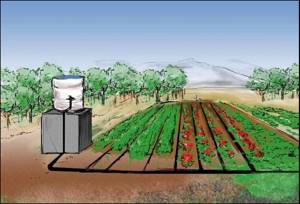
Keep in mind that plant roots will be concentrated in areas of irrigation. When designing a drip irrigation system, it is very important that the water is evenly distributed over the entire area of irrigated land, after which the plant roots will develop equally in all directions. For example, if you are irrigating large plants such as trees and shrubs, the drip location should be spread out over two or more sides of each plant to encourage roots to grow in all directions and avoid concentrating in one area. For the same reason, it is better to provide long, slow watering. Because if you organize watering in small portions, the water will not have a chance to spread far in the soil, and with drip irrigation, a uniform flow of moisture around the plant will help the roots form a strong, dense, spherical mass around the dropper supplying water.

You can create your own drip irrigation system, but most companies that sell drip irrigation equipment can create a custom design based on your wishes and needs, as well as your individual landscape, soil type and location. Their design will be completed with a list of parts and spacing between drip sprinklers. Whichever method you choose, start by creating a drawing of your site that is accurate enough to determine how many meters of pipe and drip tape you need.
If you are developing your own irrigation scheme, you can make a proposal to your neighbors to also install drip irrigation systems in their areas. This way, you can split the cost of system components that have a lower base cost when purchasing in bulk.
Watering cherries
Cherry plants have a number of specific characteristics that should be taken into account when irrigating. These features directly depend on the stage of development, climatic conditions and a number of other factors.
Cherry seedlings
You can get a good harvest only by knowing how to properly water cherry seedlings. The first time this must be done immediately after planting in the spring or autumn, by digging a small circular ditch and pouring 2-3 buckets of water into it, or by organizing drip watering of the cherries. After the water has soaked into the soil, you need to compact the soil a little to retain moisture. It is very important to carry out this procedure immediately a few hours after planting, otherwise the plant may die or grow weak and infertile.
Watering cherries is required only if the top layer of soil dries out and may stop altogether during heavy seasonal rainfall. In dry times, the plant requires more moisture and with each irrigation it is necessary to consume 10-15 liters of warm water, which has settled in a tank or barrel. Experts recommend watering in the evening, closer to sunset.
Cherry 2-5 years
At this stage of development, cherries are less demanding and do not need spring and summer irrigation, except during periods of extreme heat, drought or regular drying out of the soil. Lack of moisture during fruit filling can cause fruit cracking.
Cherry 5-15 years
At this age, cherries become even less demanding and require irrigation only during flowering or during a fairly dry period. However, at this stage of development, autumn watering takes on special importance, which must be carried out after leaf fall. Irrigate daily for a week with a water consumption of about 2 liters.
These actions will lead to improved preparation of the cherry tree for the winter and will protect the root system from frost, which is extremely negative for stone fruit crops.
Mature cherry over 15 years old
A mature cherry tree that is more than 15 years old requires combining irrigation with mineral fertilizers. To do this, you can install a drip irrigation system for cherries in the area near the tree trunk and dig small holes no more than a quarter of a meter deep, where you need to pour nutrients and cover them with soil. After this, thanks to the uniform supply of water, the soil is moistened and nourishes the tree.
High-quality and regular watering ensures the longevity and health of the tree, its appearance, and the resulting harvest. To do this, it is enough to buy drip irrigation for trees and shrubs from , and entrust all the concerns related to irrigation to it. The system has proven its superiority over other methods many times and is becoming more popular every year. It is this method of irrigation that ensures the supply of moisture to plants during critical periods of growth and development in the required quantities.
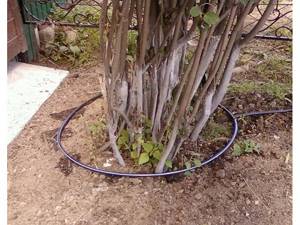
Reasons for the popularity of drip irrigation
Drip irrigation for trees and plants has many advantages, which can be discussed in a little more detail.
- Fertilizing plants. A significant part of fertilizing and fertilizers is easily dissolved in water, and with the help of drip irrigation, beneficial substances and microorganisms are distributed evenly to all plants;
- A method of protection against weeds. Moderate moisture of the top layer of soil does not create favorable conditions for weed growth. This type of watering is very convenient for fields;
- The optimal solution if you have a greenhouse. Some berries or vegetables require regular, abundant watering, which is provided by the drip system.
Drip irrigation for the lawn helps maintain a beautiful grass cover on your garden plot without waterlogging. When thinking about the question of which drip irrigation to choose for vegetables, you should take into account all the features of the location of the beds.
What does drip irrigation consist of?
The garden drip irrigation scheme consists of several components:
- Drip tape with a specific sequence of holes for water supply;
- Durable and flexible hose tube;
- Water filters that help avoid clogging of droppers with alkali;
- Small accessories - fittings, connectors, doubles and tees. Simply put - little things to assemble the system;
- Taps for directly supplying the system to the water source.
You can purchase equipment for drip irrigation in agriculture on the website of the Ovk Therm online store. The catalog contains the necessary elements and pipes of various diameters to create your own drip irrigation system.
